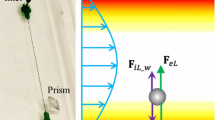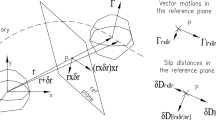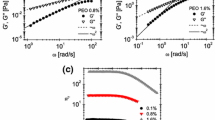Abstract
A particle level simulation model is proposed for investigating the effects of elongated particles on the microstructure and field-induced flow response in electrorheological fluids. The particles are modelled as a collection of spherical subunits joined by Hookean-type connectors, which enables the modelling of the particle motion through the Newtonian carrier liquid. Electrostatic polarisation of each particle leads to a torque, as well as interaction forces between the particles. The simulation results show a stress–strain response that demonstrates the yielding behaviour reported in electrorheological systems. The microstructural changes in the system are studied via a description of the orientational stress distribution in the system. The stress contribution arising from rotational effects is shown to be dependant on the average orientation vector of the particles at the commencement of the shearing.







Similar content being viewed by others
References
Ahn KH, Klingenberg DJ (1994) Relaxation of polydisperse electrorheological suspensions. J Rheol 38(3):713–741
Anderson RA (1992) Effects of finite conductivity in electrorheological fluids. In: Tao R (ed) Proceedings of the 3rd international conference of electrorheological fluids. World Scientific Co, Singapore, pp 81–90
Asano K, Suto H, Yatsuzuka K (1997) Influence of the particle configuration on electrorheological effect. J Electrost 40–41:573–578
Bica I (2006) Advances in magnetorheological suspension: production and properties. J Ind Eng Chem 12(4):501–515
Block H, Kelly JP (1988) Electrorheology. J Phys D Appl Phys 21:1661–1677
Cao JG, Huang JP, Zhou LW (2006) Structure of electrorheological fluids under an electric field and a shear flow: experiment and computer simulation. J Phys Chem B 110(24):11635–11639
Chin BD, Winter HH (2002) Field induced gelation, yield stress, and fragility of an electro-rheological suspension. Rheol Acta 41:265–275
Davis LC (1992) Polarization forces and conductivity effects in electrorheological fluids. J Appl Phys 72(1):1334–1340
Doi M, Edwards SF (1986) The theory of polymer dynamics. Oxford University Press, London
Ekwebelam C, See H (2009) Microstructural investigations of the yielding behaviour of bidisperse magnetorheological fluids. Rheol Acta 48:19–32
Goldsmith HL, Mason SG (1967) In: Eirich FR (ed) Rheology: theory and applications, vol 4. Academic Press, New York, p 85
Hao T (2001) Electrorheological fluids. Adv Mater 13(24):1847–1857
Hao T (2005) Electrorheological fluids: the non-aqueous suspensions. Elsevier, Amsterdam
Halsey TC, Martin JE, Adolf D (1992) Rheology of electrorheological fluids. Phys Rev Lett 68(10):1519–1523
Ikazaki F, Kawai A, Uchida K, Kawakami T, Edamura K, Sakurai K, Anzai H, Asako Y (1998) Mechanisms of electrorheology: the effect of the dielectric property. J Phys D Appl Phys 31:336–347
Jeffrey GB (1923) The motion of ellipsoid particles immersed in a viscous fluid. Proc R Soc Lond A 102:161–179
Jones TB (1995) Electromechanics of particles. Cambridge University Press, Cambridge
Joung CG (2006) Dynamic simulation of arbitrarily shaped particles in shear flow. Rheol Acta 46:143–152
Joung CG, Phan-Thien N, Fan XJ (2001) Direct simulation of flexible fibers. J Non-Newton Fluid Mech 99(1):1–36
Kanu RC, Shaw MT (1998) Enhanced electrorheological fluids using anisotropic particles. J Rheol 42(3):657–670
Kawai A, Uchida K, Ikazaki F (2002) Effects of shape and size of dispersoid on electrorheology. In: Bossis G (ed) Proceedings of the 8th international conference: electrorheological fluids and magnetorheological suspensions, Nice, France, 9–13 July 2001. World Scientific Publishing Co, Singapore, pp 626–632
Kim S, Karilla S (1991) Microhydrodynamics: principles and selected applications. Butterworth-Heinemann, Boston
Kittipoomwong D, Klingenberg DJ, Ulicny JC (2005) Dynamic yield stress enhancement in bidisperse magnetorheological fluids. J Rheol 49(6):1521–1538
Kittipoomwong D, Klingenberg DJ, Shkel YM, Morris JF, Ulicny JC (2008) Transient behavior of electrorheological fluids in shear flow. J Rheol 52(1):225–241
Klingenberg DJ, van Swol F, Zukoski CF (1991) The small shear rate response of electrorheological suspensions. I. Simulation in the point-dipole limit. J Chem Phys 94(9):6160–6169
Kuzhir P, López-López MT, Bossis G (2009) Magnetorheology of fiber suspensions, II. Theory. J Rheol 53(1):127–151
Lengalova A, Pavlinek V, Saha P, Quadrat O, Stejskal J (2003) The effect of dispersed particle size and shape on the elecrorheological behaviour of suspensions. Colloids Surf A 227:1–8
López-López MT, Kuzhir P, Bossis G (2009) Magnetorheology of fiber suspensions, I. Experimental. J Rheol 53(1):115–126
Martin JE, Anderson RA (1999) Electrostriction in field-structured composites: basis for a fast artificial muscle? J Chem Phys 111(9):4273–4280
Otsubo Y (1999) Electrorheology of whisker suspensions. Colloids Surf A 153:459–466
Parthasarathy M, Klingenberg DJ (1996) Electrorheology: mechanisms and models. Mater Sci Eng R 17:57–103
Ramos-Tejada MM, Espin MJ, Perea R, Delgado AV (2009) Electrorheology of suspensions of elongated goethite particles. J Non-Newtonian Fluid Mech. 159:34–40
Rankin PJ, Klingenberg DJ (1998) The electrorheology of barium titanate suspensions. J Rheol 42(3):639–656
Ross RF, Klingenberg DJ (1997) Dynamic simulation of flexible fibers composed of linked rigid bodies. J Chem Phys 106(7):2949–2960
See H (1999) Advances in modeling the mechanisms and rheology of electrorheological fluids. Korea–Australia Rheol J 11:169–195
See H (2004) Advances in electro-rheological fluids: materials, modeling and applications. J Ind Eng Chem 10:1132–1145
See H, Doi M (1991) Aggregation kinetics in electro-rheological fluids. J Phys Soc Jpn 60(8):2778–2782
See H, Doi M (1992) Shear resistance of electrorheological fluids under time-varying electric fields. J Rheol 36(6):1143–1163
See H, Saito T (1996) Layered model of electrorheological fluid under flow. Rheol Acta 35(3):233–241
Shulman ZP, Kordonsky VI, Zaltsgendler EA, Prokhorov IV, Khusid BM, Demchuk SA (1986) Structure, physical properties and dynamics of magnetorheological suspensions. Int J Multiph Flow 12:935–955
Stratton JA (1941) Electromagnetic theory. McGraw-Hill, New York
Takimoto JI, Minagawa K, Koyama K (1996) Numerical study of the response time of ER suspensions. In: Bullough WA (ed) Proceeding of the 5th international conference on electro-rheological fluids, magneto-rheological suspensions and associated technology, Sheffield, UK, 10–14 July 1995. World Scientific Publishing Co, Singapore, p 209
Tan Z, Zou X, Zhang W, Jin Z (1999) Influences of the size and dielectric properties of particles on electrorheological response. Phys Rev E 59(3):3177–3181
Tao R, Jiang Q (1994) Simulation of structure formation in an electrorheological fluid. Phys Rev Lett 73(1):205–208
Tao R, Jiang Q (1998) Structural transitions of an electrorheological and magnetorheological fluid. Phys Rev E 57(5):5761–5765
Tsuda K, Takeda Y, Ogura H, Otsubo Y (2007) Electrorheological behavior of whisker suspensions under oscillatory shear. Colloids Surf A 299:262–267
Wang Z, Lin Z, Fang H, Tao R (1998) Dynamic response times of electrorheological fluids in steady shear. J Appl Phys 83(2):1125–1131
Whittle M (1990) Computer simulation of an electrorheological fluid. J Non-Newton Fluid Mech 37:233–263
Yamamoto S, Matsuoka T (1993) A method for dynamic simulation of rigid and flexible fibers in a flow field. J Chem Phys 98(1):644–651
Yamamoto S, Matsuoka T (1994) Viscosity of suspensions of rod-like particles: a numerical simulation method. J Chem Phys 100(4):3317–3324
Acknowledgements
Yann Kae Kor acknowledges the support of the Postgraduate Scholarship in Electrorheological Research made available for this study, and the authors acknowledge the support of the Australian Research Council.
Author information
Authors and Affiliations
Corresponding author
Rights and permissions
About this article
Cite this article
Kor, Y.K., See, H. The electrorheological response of elongated particles. Rheol Acta 49, 741–756 (2010). https://doi.org/10.1007/s00397-010-0445-x
Received:
Revised:
Accepted:
Published:
Issue Date:
DOI: https://doi.org/10.1007/s00397-010-0445-x




